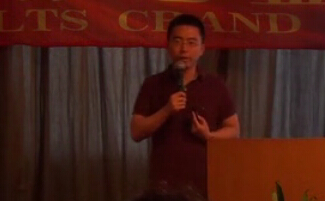雅思作文怎么找到好的论点
2013-07-25 11:41 供稿单位: 新航道
出国英语考试有哪些 雅思6.5是什么水平 雅思阅读评分标准 托福阅读评分标准 雅思和托福的区别
烤鸭们拿到雅思作文题目个想法是什么呢?头脑风暴?词句风暴?无论如何,在动笔之前心里一定要给出一个outline!安排一个大概的结构和思路,否则,很有可能写到一半就断线~也有可能写到发现跑题咯~
总而言之,写作之前还是好好为你的大作选几个好的ideas,并把它们组织起来~~下面就看看具体怎么操作吧!
Planning IELTS essays and finding ideas
This lesson looks at how planning better can help you write better essays. I focus in particular on “ideas” – something that catches many candidates out. The two key points are that the ideas you need to write an IELTS essay are fairly simple and it helps to make a difference between ideas, reasons and examples.
Problem 1 – not enough ideas 观点不够
This is one of most common reasons for candidates to go wrong in the writing paper. They see a question. Try to think of ideas. Come up empty and panic. You will find part of my solution to this below. For now, I will just say that you need very few ideas to write a good essay and those ideas can be simple ideas too. Don’t buy a book on ideas for essays, instead learn this tip:
Tip – you need only 2 ideas to write an essay and those ideas are often found in the question
Problem 2 – the ideas are confused 观点混淆
This is also a very common mistake. There are plenty of ideas to write an essay. The problem is that the reader/examiner does not know what the main ideas are.
Tip – make sure you have one main idea per paragraph. This should be clear from the first sentence of the paragraph
Problem 3 – too many ideas 观点太多
Yes, some people do have too many ideas. This is a trap for candidates aiming for a high score. In particular, if they are used to writing academic essays. IELTS is a 250 word essay marked on language. That means it is probably much shorter than you are used to and there are no marks for quality and quantity of ideas.
Tip – select only enough ideas to write a complete essay – that means one per paragraph
Finding ideas for essays 怎么确定观点呢?、
Step 1 – understand the difference between ideas, reasons and examples 区分观点、原因、例子的区别
When I ask my students in a class for “ideas”, they quite often stare at me in silence. When I ask them the question “why” or ask them to give me an example, they (normally!) have plenty to say. That should tell you there is a difference between ideas, reasons (why) and examples. The good news is ideas are not the problem in IELTS, what you need are reasons and examples. They are normally much easier to find.
A paragraph is one idea: supported with reasons and examples. You only need two ideas.
Step 2 – learning where to find ideas for essays?试着从问题里找观点
The ideas you need for an essay are nearly always found in the question. They are typically so big that you think they are too easy to be a real idea. That’s the trap. What do I mean? Take this example:
Human activities have endangered many animal and plant species. Some people think it is too late to save them, while others think humans should still take some action. Discuss both views and express your own opinions.
This is one of the harder questions I have seen recently, but the ideas you need are simple enough.
It is too late to save endangered species
It is not too late to save species
It is that easy. Those two ideas are your two main topic paras. All you need now are some reasons and examples.
Step 3 – finding reasons and examples – ask yourself questions 通过问问题来确定原因和例子
Here you have different options. One trick is simply ask yourself the questions “why?” or “how?” or “when?” or what?” That is often enough.
Step 4 – thinking vocabulary gives you more “ideas” 通过词汇来激发灵感
This is something else I use with my students a lot. It might also work for you. The concept is that once you have words, then “ideas” come naturally from those words. Try thinking of “planning words” and see if it works for you.
Organising and selecting your ideas reasons and examples
Key concept – one idea per paragraph supported by reasons and examples 一段一观点
Look at these two sample paragraphs from the essay and see how I use simple ideas from the question:
Much of the argument against taking any action to save these species is that the process is irreversible. Just to take one example, there are now so few Giant Pandas left in the wild, they will in all probability become extinct in the foreseeable future. There are simply too few bamboo forests left in order for them to survive. This is also the case with many other endangered species who have lost, or are losing, their natural habitat.
NotesThe first sentence outlines what the paragraph is about. It is the idea from the question: Some people think it is too late to save them. The rest of paragraph is an explanation of that idea
Giant Pandas arre threatened and will die out (example)
Problem with habitat (extended example)
Other species have same pattern (explanation of example)
The opposite view is that it is the responsibilty of mankind to act and try and save these species for posterity.There is a moral aspect to this argument because most of these species are only endangered because of man’s actions and it is our duty to make amends. Another consideration is that advances in science, especially in the field of genetics, mean that we may be able to recreate some of their lost habitats. It is no longer the case that the only option is to preserve these species for future generations in zoos and botanical gardens.
Notes
You should see that this paragraph follows almost the same model. There is one clear and simple idea in the first sentence. It relates back to the question words: while others think humans should still take some action. The rest of the paragraph explains that idea:
moral duty because it is our fault (reason why)
science can now help through genetics (second reason why)
zoos are not the only solution (extended second reason why)
Key concept – you don’t need to include all your reasons and examples
My “notes” for this essay included all this. They are my notes, so you don’t need to understand them all. What I want you to see is that I have not included everything. In an academic essay I might have. Here I have selected the ideas that were easiest to write about.
zoos (example)
breed in captivity (example extended)
preservation (how)
giant pandas (example)
medical benefits (why)
loss of habitat (why)
river dolphins (example)
biodiversity (reason)
logging and rainforests (example)
dams (example)
progress of man (why)
deforestation (how)
bamboo forest (where)
science (why)
cloning (example)
genetics (example)
moral responsibility (why)
Key concept – balance your paragraphs
There are a number of different possible essay structures. My default (normal) structure is to have 2 paragraphs that balance each other – it is surprising how often this structure works. It is good for the coherence of the essay, it also makes it easier to write – especially if you are short of “ideas”. You use the second content paragraph can reflect the ideas in the first paragraph, but from the opposite point of view.
以上就是新航道雅思频道为大家整理的雅思作文怎么找到好的论点,希望对大家有帮助,更多资讯、资料请访问新航道雅思写作频道 https://www.xhd.cn/ielts/xiezuo/
- 上一篇:雅思写作素材十大类(1)
- 下一篇:提高雅思写作的五种实用方法
分享到:

- 新航道,英语成功之道。时间获取新航道英语学习资料和新鲜资讯,请在微信公众账号中搜索「新航道英语」或者「xhdenglish」,或用手机扫描左方二维码,即可获得新航道每日精华内容推送和英语学习经验分享,并参与新航道举办的各项活动。
责编:李术
图文资讯:
精彩专题
更多视频荟萃
更多
-
新航道姚骏鹏-雅思阅读高分攻略
时长:03-06

-
新航道陈侃侃-雅思口语要有范儿
时长:03-06

-
【3分钟学雅思】王大锤告诉你为啥药不能停
时长:01-12

-
【3分钟学雅思】全世界个感官餐厅
时长:01-12
热门文章
更多
-
8月31日雅思广州考机考初体验
选择机考模式的考生将通过机考模式参加听...








